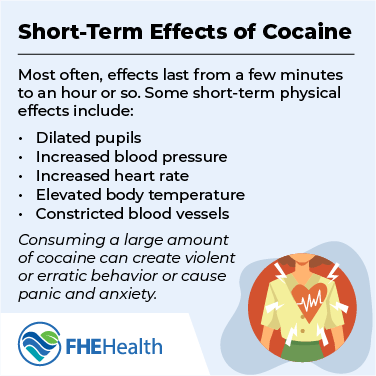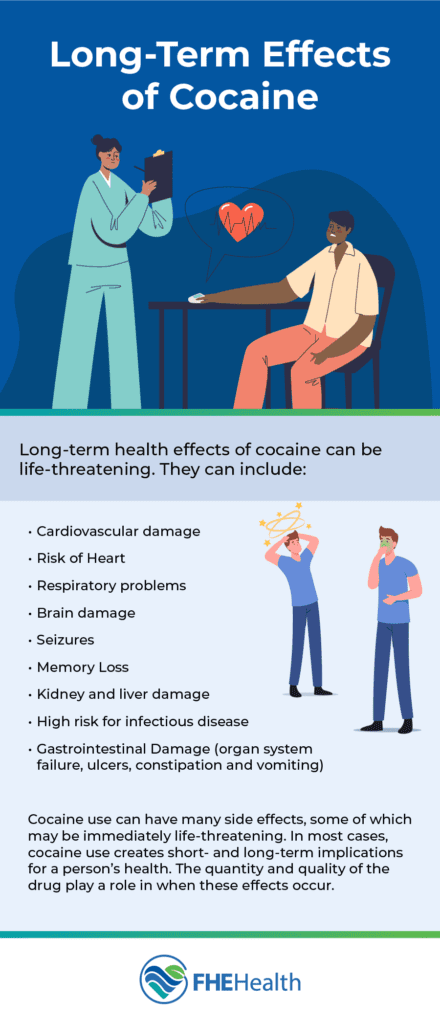Cocaine is a powerful drug that can cause addiction rapidly. About 1.5 million people reported using cocaine in the previous month in 2014, according to the National Institutes on Drug Abuse. The most common users are those between the ages of 18 and 25. Understanding this drug can help addicted users understand its effects and the importance of getting help. Studies have shown that the longer a person is in formal treatment for addiction, the less likely they are to suffer relapse.
What Is Cocaine?
Cocaine comes from the leaves of the coca plant. It is a stimulant and creates a nearly instant high when used. Cocaine works by boosting levels of dopamine, a neurotransmitter known as the feel-good chemical produced by the brain. When high, a person may feel as though they have superhuman strength, energy and ability.
Cocaine can make a person feel great but is also very addictive. The problem is that cocaine makes the heart work harder, pushes the lungs further and can cause side effects that are dangerous to your health.
What Are Common Forms of Cocaine?
There are several types of cocaine. It can be used alone but is typically mixed with other drugs. Crack cocaine is one example. It is called this because it makes a crackling noise when a user heats it to smoke it.
Other forms exist as well, including speedball, which is an injectable combination of cocaine and heroin linked to several prominent deaths including Chris Farley, Mitch Hedberg, Phillip Seymour Hoffman and River Phoenix. Freebase is a refined hydrochloride salt form of cocaine that is highly dangerous.
How Do You Identify Cocaine?
The salt version of cocaine, sometimes just called “coke,” is generally available as a white powder. It looks and feels like baby powder—in fact, it is often mixed with baby powder to dilute it. It can vary in color from pure white to yellowish.
Crack cocaine looks like small rocks or pieces of salt. It tends to be an off-white color but can have a pinkish hue. In some cases, it can be in a powder form.
What makes cocaine harder to identify is that it can often be mixed with other drugs, which alters its appearance. Sometimes, you can identify cocaine by the smell. It may smell like the other drugs in the mixture, such as bath salts or synthetic coke. Unmixed cocaine may have a slightly floral scent.
What Are Slang Terms for Cocaine?
There are many terms for both cocaine in its powder form and crack cocaine. The drug has a long history, and each era has added terms to cocaine’s list of nicknames.
Some common terms for cocaine include:
- Blow
- Coke
- Snow
- Sniff
- Flake
- Dust
- Icing
- Bump
Some common terms for crack cocaine include:
- Hard rock
- Candy
- Black rock
- Sleet
- Jelly beans
- Hail
- Moon rock
- Dice
The ever-changing nature of the drug scene means that terms associated with these drugs will evolve too. Regardless of what people choose to call cocaine, however, it is what it is: a dangerous and addictive substance. In 2017, one in four overdose deaths involved cocaine.
How Is Cocaine Used?
People use cocaine by snorting, smoking, or injecting it. Snorting involves inhaling the cocaine powder through the nostrils. The drug enters the bloodstream through the user’s nasal tissues. Injecting the drug means that the cocaine enters the bloodstream in mere moments. When smoking the drug, users inhale cocaine vapors into their lungs; then, the drug is absorbed into the bloodstream. Smoking and injecting allow for rapid absorption into the bloodstream, but the intense high also tends to be shorter-lived than when snorting the drug.
Each method of cocaine use carries a risk for addiction, overdose, and other severe health problems. Users who inject the drug and share needles are at increased risk for contracting diseases such as hepatitis and HIV/AIDS. The risk for overdose is high for cocaine because it is often used in “binges.
For instance, injecting and smoking the drug cause an intense but shorter-lived high that only lasts for about 10 minutes. In order to sustain the high, users take even more of the drug in increasing doses. In such cases, the risk for developing a tolerance and then dependence is great as is taking too much of the drug in one sitting, which can lead to overdose and medical emergency.
What Are the Effects of Cocaine?
Cocaine use can have many side effects, some of which may be immediately life-threatening. However, people can use the drug for long periods without having many outward signs. In most cases, cocaine use creates short- and long-term implications for a person’s health. The quantity and quality of the drug play a role in when these effects occur.
Short-Term Effects of Cocaine
 A person will experience some type of effect, even with a single dose. Most often, effects last from a few minutes to an hour or so. Smaller amounts may create feelings of euphoria and energy. Some people may gain mental sharpness and become talkative. Other people become very sensitive to sound, touch and sights around them. For some, cocaine suppresses the desire to eat or drink.
A person will experience some type of effect, even with a single dose. Most often, effects last from a few minutes to an hour or so. Smaller amounts may create feelings of euphoria and energy. Some people may gain mental sharpness and become talkative. Other people become very sensitive to sound, touch and sights around them. For some, cocaine suppresses the desire to eat or drink.
Some short-term physical effects include:
- Dilated pupils
- Increased blood pressure
- Increased heart rate
- Elevated body temperature
- Constricted blood vessels
Consuming a large amount of cocaine can create violent or erratic behavior or cause panic and anxiety. Severe medical complications, including irregular heart rhythms, seizures, stroke, heart attack and neurological effects, can occur.
Long-Term Effects of Cocaine
 Any of these short-term effects can create lasting problems for a cocaine user. The long-term health effects of cocaine can be life-threatening. They can include:
Any of these short-term effects can create lasting problems for a cocaine user. The long-term health effects of cocaine can be life-threatening. They can include:
- Cardiovascular damage, including high blood pressure, constriction of blood vessels in the brain, increased risk of aneurisym, and a sustained rapid heart rate, can occur.
- Heart attacks become increasingly common in individuals with long-term use.
- Respiratory problems can occur, including pain, wheezing sounds, inferior lung function and coughing.
- Brain damage can happen, including shrinkage of the brain, inflammation of the blood vessels in the brain, seizures and changes to a person’s ability to speak, learn, remember and maintain attention.
- Kidney and liver damage are both common.
- Some people are at a higher risk for infectious disease due to sharing needles.
- Gastrointestinal damage may include organ system failure, ulcers, constipation and vomiting.
Cocaine use can have many side effects, some of which may be immediately life-threatening. However, people can use the drug for long periods without having many outward signs. In most cases, cocaine use creates short- and long-term implications for a person’s health. The quantity and quality of the drug play a role in when these effects occur.
Cocaine’s Place with Other Abused Drugs
Cocaine is a widely trafficked drug. It is dangerous in terms of addiction and health risks and in some cases is as dangerous as fentanyl. It is also a high-risk drug, because it is often combined with other substances, including other illegal drugs that can heighten its effect. Cocaine is dangerous when used alone, but when taken with other drugs, the danger is considerably heightened.
A History of Cocaine Use
 Historically, coca, the plant from which cocaine comes, has been used as a stimulant. The Incas, who lived at high elevations in the Andes Mountains, used it as a way to speed up their heart rate and breathing and as a common part of religious ceremonies. Subsequently, Spanish conquerors in the same regions forced locals to mine silver by feeding them coca leaves, exploiting their ability to work while feeding their addiction.
Historically, coca, the plant from which cocaine comes, has been used as a stimulant. The Incas, who lived at high elevations in the Andes Mountains, used it as a way to speed up their heart rate and breathing and as a common part of religious ceremonies. Subsequently, Spanish conquerors in the same regions forced locals to mine silver by feeding them coca leaves, exploiting their ability to work while feeding their addiction.
Later, coca was a treatment given to people who were sexually impotent and those with depression. Sigmund Freud used and recommended it himself. In 1886, it was an ingredient in a new soft drink called Coca-Cola, creating energizing effects to help people do more with their day. Various medications and potions containing cocaine were sold throughout the early 1900s.
Soon, it became evident that coca had a negative impact on society. Coca-Cola removed the ingredient in 1903, but people were already snorting it in 1905. Deaths from overdosing continued to climb and, in the 1970s, the drug was considered a fashion statement for professionals and those in Hollywood. Drug cartels continued to feed the drug into the United States long after it became illegal in 1922.
How Is Cocaine Addictive?
Cocaine is one of the most addictive drugs used today, but it is important to recognize how addiction happens. While cocaine has numerous physical effects, its impact on the health of the brain and overall brain function makes it especially dangerous. Initial addiction comes from the way it speeds up the heart rate and gives people energy, focus, and a lack of fear. This, in itself, can encourage people to continue to use it.
One dose of cocaine can create a need for more. Overdose is not uncommon and occurs when the brain and body can’t process the amount of chemical reaction occurring.
Within the brain, cocaine causes a dramatic spike in the production of a neurochemical called “dopamine,” which helps improve mood and creates good feelings. Dopamine is natural and does not cause harm to the brain. However, when cocaine is ingested, the artificial build-up of dopamine can create a significant high, lasting for several minutes to an hour. When this happens over a period of time, the brain begins to alter the way it functions to account for the presence of the drug. This changes the chemistry and messaging of the brain.
Cocaine tolerance builds up as well. This means the brain requires more of the drug on an ongoing basis to induce the same feelings, increasing the risk of overdose.
What to Do About Cocaine Addiction
Cocaine addiction is possible even with a small amount of cocaine use over a short time. Treatment may require detox, which can create life-threatening complications, especially if attempted without medical supervision. It is therefore important to undergo detox in a safe, clinical setting where physicians can treat withdrawal symptoms to reduce their severity and can manage any medical complications that might occur.
If you or a loved one is living with cocaine addiction, reach out to FHE Health for an assessment and treatment options.
This article has been reviewed for accuracy by our peer review team which includes clinicians and medical professionals. Learn more about our peer review process.








